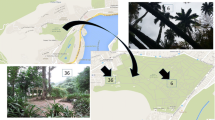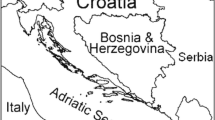Abstract
The volatile organic compounds (VOCs) emitted from vegetation into the atmosphere play an important role in atmospheric chemistry and participate in the formation and growth of aerosol particles that affect the atmospheric radiation balance and the earth’s climate. A number of VOCs, such as isoprene, monoterpene, methylvinylketone, and methacrolein, whose surface concentrations were measured between Moscow and Vladivostok in the course of the Transcontinental Observations into the Chemistry of the Atmosphere (TROICA-12) experiment in July–August 2008, are considered. For the first time in Russia, a PTR-MS proton mass-spectrometer was used to measure the VOC concentrations. The continuous series of VOC concentrations in the atmosphere over the Trans-Siberian Railway were obtained, and the characteristic features of their variations were determined. The spatial distribution of the concentrations of biogenic VOC was compared with a map of Russia’s forests. It was found that the maximum concentrations of isoprene between Moscow and Vladivostok correspond to the zones of broad-leaved forests in the Far East and Primorskii Krai, and the maximum concentrations of monoterpene correspond to coniferous forests in Siberia. The obvious correlation between the concentrations of isoprene and the total concentration of methylvinylketone and methacrolein was revealed.
Similar content being viewed by others
References
A. Guenther, C. N. Hewitt, D. Erickson, et al., “A Global Model of Natural Volatile Organic Compound Emissions,” J. Geophys. Res. 100(D5), 8873–8892 (1995).
H. B. Singh and P. Zimmerman, Atmospheric Distribution and Sources of Nonmethane Hydrocarbons, in Gaseous Pollutants Characterization and Cycles, Ed. by J. D. Nriagu (Wiley, New York, 1992), pp. 117–235.
V. Tarvainen, Development of Biogenic VOC Emission Inventories for the Boreal Forests (Finnish Meteorological Institute, Helsinki, 2008).
A. Shvidenko and S. Nilsson, “What do We Know about the Siberian Forests?,” Ambiology 23(7), 396–404 (1994).
TROICA Movable Observatory and Observations of the Composition of the Atmosphere over Russia, Ed. by N. F. Elanskii (Obukhov Institute of Atmospheric Physics, Moscow, 2006) [in Russian].
I. B. Belikov, “Gas Admixtures in the Atmosphere over Russia According to Observations with an Automated Complex of Instruments,” in Candidate’s Dissertation in Mathematics and Physics (Obukhov Institute of Atmospheric Physics, Moscow, 2004) [in Russian].
W. Lindinger, A. Hansel, and A. Jordan, “On-Line Monitoring of Volatile Organic Compounds at Pptv Levels by Means of Proton-Transfer-Reaction Mass Spectrometry (PTR-MS). Medical Applications, Food Control and Environmental Research,” Int. J. Mass Spectrom. Ion Process 173, 191 (1998).
C. Warneke, C. van der Veen, S. Luxembourg, et al., “Measurements of Benzene and Toluene in Ambient Air using Proton-Transfer-Reaction Mass Spectrometry: Calibration, Humidity Dependence, and Field Intercomparison,” Int. J. Mass Spectrom. Ion Proc. 207, 167 (2001).
T. J. Christian, B. Kleiss, R. J. Yokelson, et al., “Comprehensive Laboratory Measurements of Biomass-Burning Emissions: 2. First Intercomparison of Open-Path FTIR, PTR-MS, and GC-MS/FID/ECD,” J. Geophys. Res. Atmos. 109(D02311) (2004).
R. Holzinger, A. Lee, K. T. Paw, et al., “Observations of Oxidation Products above a Forest Imply Biogenic Emissions of Very Reactive Compounds,” Atmos. Chem. Phys. 5, 67–75 (2005).
S. A. Bartalev, D. V. Ershov, A. S. Isaev, et al., Map of Forests of the Russian Federation (Moscow, 2004) [in Russian].
O. A. Tarasova, K. A. M. Brenninkmaier, N. F. Elanskii, et al., “Study of Variability in Carbon Monoxide Concentration over Russia According to the TROICA Expedition Data,” Opt. Atmos. Okeana, No. 5, 511–516 (2005).
A. V. Andronova, I. G. Granberg, D. P. Gubanova, et al., “Spatiotemporal Distribution and Elemental Composition of Atmospheric Aerosol on the Moscow-Khabarovsk Road,” Opt. Atm. Okeana 20(10), 910–916 (2007).
NIST Chemical Kinetics Database, http://kinetics.nist.gov/kinetics/index.jsp
A. Guenther, et al., “MEGAN Estimates of Global Isoprene,” Atmos. Chem. Phys. 6, 3181–3210 (2006).
Author information
Authors and Affiliations
Corresponding author
Additional information
Original Russian Text © I.I. Timkovsky, N.F. Elanskii, A.I. Skorokhod, R.A. Shumskii, 2010, published in Izvestiya AN. Fizika Atmosfery i Okeana, 2010, Vol. 46, No. 3, pp. 347–356.
Rights and permissions
About this article
Cite this article
Timkovsky, I.I., Elanskii, N.F., Skorokhod, A.I. et al. Studying of biogenic volatile organic compounds in the atmosphere over Russia. Izv. Atmos. Ocean. Phys. 46, 319–327 (2010). https://doi.org/10.1134/S0001433810030059
Received:
Accepted:
Published:
Issue Date:
DOI: https://doi.org/10.1134/S0001433810030059




